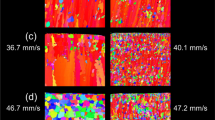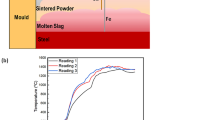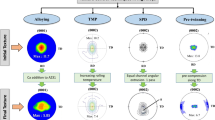Abstract
New Rheocasting (NRC) is a recently developed semisolid processing route. There are two versions of this route. In one, molten alloy is poured directly into a mould and through careful temperature control during cooling a spheroidal semisolid microstructure is achieved, before the material in the mould is upended into a shot sleeve and hence forced into a die. Alternatively, the molten alloy is poured onto a cooling slope and thence into a mould before processing. The aim of the work described in this paper, and its companion, was to develop the understanding of the microstructural development during the initial stages of this process, i.e. in the mould before processing and with the cooling slope/mould combination. In the previous paper, an analogue system based on aqueous ammonium chloride has been used to visualise what happens when an alloy is poured into a tilted mould with a chill wall, which acts to mimic the mould and the cooling slope in the NRC process. In this companion paper, the results for pouring A356 aluminium alloy directly into a mould, and also via a cooling slope into a mould, are presented.
















Similar content being viewed by others
References
Legoretta EC, Atkinson HV, Jones H (submitted) J Mater Sci. doi:https://doi.org/10.1007/s10853-008-2828-2
Spencer DB, Mehrabian R, Flemings MC (1972) Metall Trans 3:1925. doi:https://doi.org/10.1007/BF02642580
Flemings MC (1991) Metall Trans A22:957
Kirkwood DH (1994) Int Mater Rev 39:173
de Figuredo A (ed) (2001) Science and technology of semi-solid processing. North American Die Casting Association, Rosemont, IL
Fan Z (2002) Int Mater Rev 47:49. doi:https://doi.org/10.1179/095066001225001076
Atkinson HV (2005) Prog Mater Sci 50:341. doi:https://doi.org/10.1016/j.pmatsci.2004.04.003
Kaneuchi T, Shibata R, Ozawa M (2002) In: Tsutsui Y, Kiuchi M, Ichikawa K (eds) Proceedings of the 7th international conference on advanced semi-solid processing of alloys and composites, Tsukuba, Japan, 2002. National Institute of Advanced Science and Technology and the Japan Society for Technology of Plasticity, Japan, p 145
Mitsuru A, Hiroto S, Yasunori H, Tatsuo S, Satoru S, Atsushi Y (1996) Patent EP 0745694 A1
Hall K, Kaufmann H, Mundl A (2000) In: Chiarmetta GL, Rosso M (eds) Proceedings of the 6th international conference on semi-solid processing of alloys and composites, Turin, Italy, 2000. Edimet Spa, Brescia, Italy, p 23
Kaufmann H, Wabusseg H, Uggowitzer PJ (2000) Aluminium 76:70
Xia K, Tausig G (1998) Mater Sci Eng A 246:1. doi:https://doi.org/10.1016/S0921-5093(97)00758-2
Uggowitzer PJ, Kaufmann H (2004) Steel Res Int 75:525
Zhu MF, Kim JM, Hong CP (2001) ISIJ Int 41:992. doi:https://doi.org/10.2355/isijinternational.41.992
Mitsuru A, Hiroto S, Yasunori H, Tatsuo S, Satoru S, Atsushi Y (1990) Patent EP 0,392,998A1
Lee SY, Lee SM, Hong CP (2000) ISIJ Int 40:48. doi:https://doi.org/10.2355/isijinternational.40.48
Haga T, Kouda T, Motoyama H, Inoue N, Suzuki S (1998) In: Proceedings of the ICAA7, aluminium alloys: their physical and mechanical properties, Charlottesville, VA. Trans Tech Publications 2000 Part 1, Zurich, p 327
Haga T (2002) J Mater Process Technol 130–131:558. doi:https://doi.org/10.1016/S0924-0136(02)00765-3
Lima Filho AD, Yamasaki MI (2006) Solid State Phenom 116–117:433
Ashouri S, Nili-Ahmadabadi M (2006) Solid State Phenom 116–117:201
Birol Y (2006) Mater Sci Forum 519–521(Part 1–2):1919
Birol Y (2007) J Mater Process Technol 186:94. doi:https://doi.org/10.1016/j.jmatprotec.2006.12.021
Liu D, Atkinson HV, Kapranos P, Jirattiticharoean W, Jones H (2003) Mater Sci Eng A 361:213. doi:https://doi.org/10.1016/S0921-5093(03)00528-8
Seidl I, Kopp R (2004) Steel Res Int 75:545
Pahlevani F, Nili-Ahmadabadi M (2004) Int J Cast Met Res 17:157. doi:https://doi.org/10.1179/136404604225020560
Huang WD, Wang WL, Lin X, Wang M (2006) Solid State Phenom 116–117:193
Davis JR (ed) (1993) Speciality handbook ASM aluminium and aluminium alloys. ASM International, Materials Park, p 639
Haga T, Kapranos P (2002) J Mater Process Technol 118:581. doi:https://doi.org/10.1016/S0924-0136(02)00817-8
Piao PY, Motegi T (2004) J Jpn Inst Met 68:228. doi:https://doi.org/10.2320/jinstmet.68.228
Haga T, Suzuki S (2001) J Mater Process Technol 118:169. doi:https://doi.org/10.1016/S0924-0136(01)00888-3
Southin RT (1967) The solidification of metals. Iron and Steel Institute, London, p 306
Flemings MC (1974) Solidification processing. McGraw-Hill Book Co, New York
Acknowledgements
E.C.L. would like to acknowledge financial support provided by CONACyt and SEP and also the Universidad Autónoma del Estado de Hidalgo for support. The authors are grateful to the Department of Engineering Materials at the University of Sheffield for the provision of laboratory facilities. In addition, we would like to thank Prof. T. Haga who built the initial version of cooling slope equipment at Sheffield University during a sabbatical period from the University of Osaka, and Dr. Plato Kapranos and Dr. Worawit Jirattiticharoean for experimental assistance. H.V.A. would like to thank the University of Leicester for sabbatical leave.
Author information
Authors and Affiliations
Corresponding author
Rights and permissions
About this article
Cite this article
Legoretta, E.C., Atkinson, H.V. & Jones, H. Cooling slope casting to obtain thixotropic feedstock II: observations with A356 alloy. J Mater Sci 43, 5456–5469 (2008). https://doi.org/10.1007/s10853-008-2829-1
Received:
Accepted:
Published:
Issue Date:
DOI: https://doi.org/10.1007/s10853-008-2829-1




